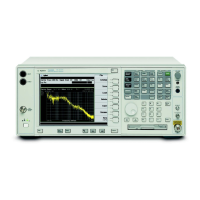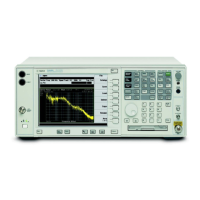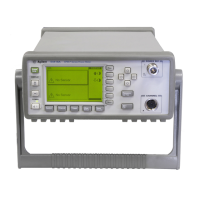Chapter 4 203
Instrument Functions: P - Z
Peak Search
Instrument Functions: P - Z
4.1 Peak Search
Places a marker on the highest peak and displays the search menu. If Peak Search Type
(Param) is set to Excursion & Threshold, the peak found must meet the defined peak
excursion and threshold values. (See “Search Param” on page 206.) Peaks that are less
than 1% of the current span away from 0 Hz are ignored. For example, if
Span is 1 MHz,
peaks will not be found between
−10 kHz and +10 kHz. If no valid peak is found, an error
(
No Peak Found) is displayed. To clear this message, press ESC before attempting another
search.
The peak search parameters are Peak Threshold and Peak Excursion. All searches except
Peak Search (Next Peak, Next Left, Next Right, Peak Table, SCPI “PEAKS” command)
obey the Search Parameters, which means that only peaks which rise above the Peak
Threshold by at least the Peak Excursion are found. Peak Search obeys then when Peak
Search is in PARAM mode. When the Peak Search key is in MAX mode, the search
parameters are ignored for a Peak Search.
NOTE You can go into the Peak Search menu without actually performing a Peak
Search
by using the front-panel Return key (assuming you have previously
accessed the Peak Search menu). Press
Return to navigate through the
previously accessed menus until you return to the Peak Search menu.
Remote Command:
:CALCulate:MARKer[1]|2|3|4:MAXimum
Remote Command Notes: The :CALC:MARK:PEAK:SEARC:MODE MAX|PAR
command specifies how a peak is identified for use with the marker
commands. See “Peak Search” on page 209.
Example:
CALC:MARK2:MAX performs a peak search using marker 2.
CALC:MARK2:Y? queries the marker amplitude (Y-axis) value for marker 2.
For more information on this command, see “Marker” on page 167.
CALC:MARK2:X? queries the marker frequency or time (X-axis) value for
marker 2. For more information on this command, see “Marker” on
page 167.

